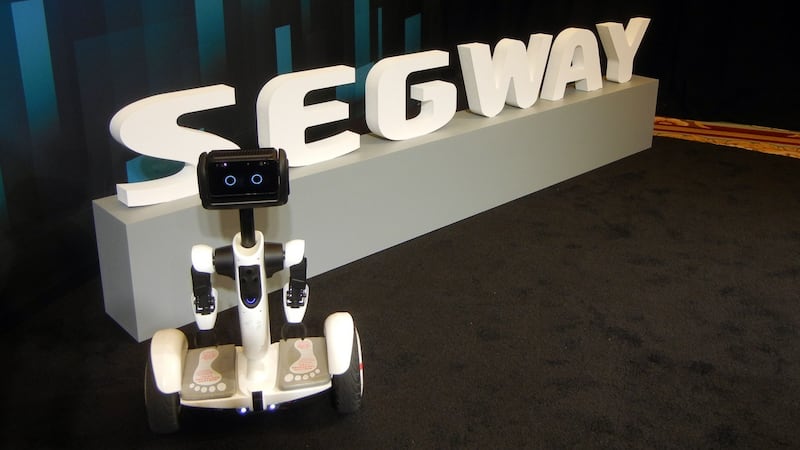In the past few days I've repaired a robot, driven a Rover across Mars and zapped objects with a laser gun. And I did it all while mostly standing around in a far less interesting place: Las Vegas, where the International CES, the giant consumer electronics trade show, was being held.
To escape from the artificial reality of Sin City, I spent a few days trying out different virtual-reality headgear and applications to assess whether VR was a gimmick or a lasting trend.
My verdict: virtual reality is here to stay, partly because the content looks and feels great (and also because so many tech companies will not stop talking about it). Whether it ends up having wide consumer appeal depends on how the companies market the technology – and whether they bring VR device prices down.


In the near term, virtual reality will probably appeal mostly to gamers and tech enthusiasts, largely because of the high price of having a solid virtual reality experience in the home. Facebook says its Oculus Rift device, which will be released in March, will cost $599, or $1,500 when bundled with a computer.
But considering the high quality of the early content and applications already made for virtual reality, and given the amount of cash that companies are investing in the medium, this is probably not a fad that will fizzle out like 3D television.
VR companies say 2016 is the year many consumers will try out virtual reality for the first time and perhaps be wowed, though it will not be the year that it reaches mass adoption in terms of sales.
"I haven't had anyone yet try the Rift and take it off and say, 'I didn't get it, that's not incredible'," said Oculus chief executive Brendan Iribe. "Most people's reaction is: 'That's probably the best thing I've ever seen in technology in my life'."
Virtual reality has come a long way. Technologists have been tinkering with the concept since the 1980s, but the first mature VR devices and apps only began emerging in the past three years.
Oculus, which was acquired by Facebook for $2 billion in 2014, has attracted the most headlines. But plenty of other companies now have a stake in virtual reality, including Samsung Electronics, Valve, Jaunt, HTC and Fox Entertainment Group.
During my virtual reality jaunts at the trade show, I strapped on the Rift headgear, which connects to a computer, and looped the two controllers around my hands to test two applications. An app called Toybox places a user in a virtual playroom surrounded by objects that you can pick up and interact with, including ping pong paddles, a laser gun, a slingshot and fireworks.
Another player can join you in the session, to hit the ping pong ball or shoot a paintball at you with the slingshot.
Strife on Mars
Fox Entertainment also demonstrated a VR app it developed for Oculus to promote the movie
The Martian
. The app gives you the opportunity to be the astronaut played by
Matt Damon
who is left stranded on Mars. The experience, which lasted about 20 minutes, consisted of seven scenarios, including a sequence where you use the hand controllers to operate a crane to load solar panels onto the Mars Rover.
A less enthralling scene involved sorting potatoes by throwing them into different buckets. I was lousy at tossing the potatoes into the buckets, just as I am inadequate at throwing objects in real life.
HTC, the technology maker based in Taiwan, has also developed virtual reality headgear called Vive with the help of Valve, the games distribution company. Vive, which will be available in April, connected to a powerful computer to deliver graphics that were even more rich and intense than Rift's.
I tried a handful of apps, including Tilt Brush, developed by Google, which let me draw brush strokes in three-dimensional space, in what was a pretty mesmerizing experience. A game app, Aperture, placed me in a robot repair facility and instructed me to open drawers, pull levers and push different buttons to repair robots.
The hand controllers for both Rift and Vive took some time getting used to, but it felt natural to interact with objects on both devices. I figured out how to repair the Aperture robot and operate the crane in The Martian app without any help.
Chet Faliszek, a videogame writer at Valve, said the intuitiveness of virtual reality should open the medium to broad applications, not just games.
“The applications and the different ways that they can be used are so diverse,” he said.
Rift and Vive had some major differences. Rift is designed for use while standing or sitting. Vive encourages you to walk around – there is a front-facing camera on the headgear to let you peek into the real world with the press of a button, in case you want to grab a glass of water, for instance.
Both devices had some flaws. Rift was difficult to wear on my face; I failed to orient the device to block out the outside world in a space under my nose (perhaps because I have a long nose) and a quick head movement made the headgear go out of focus and require a readjustment. Because Vive encourages moving around, I tripped over the cord a few times.
With both devices, I felt exhausted and overstimulated after 20-minute sessions – virtual reality feels like media designed to be consumed in small doses, not hours at a time.
Limited appeal
Oculus and Vive are initially targeting gamers with their products, and there are limits to the appeal of the systems. Consider the aesthetics of the headgear, which could be off-putting to everyday consumers. Both pieces still look freakishly sci-fi, like something out of
Star Trek
.
When I pointed that out to executives of Jaunt, which provides a camera and software for companies to produce VR content, they presented a smartphone wearing a case called the Figment VR. The Figment VR, a Kickstarter-backed phone case, includes two lenses that pop out of the case so you can quickly view virtual- reality content on a smartphone screen.
Jaunt, which hopes to one day to become the "Netflix of VR," believes that, at least initially, the smartphone, not fancy headgear such as Rift or Vive, will be the key to mass consumer adoption of virtual reality.
"It's all about smartphone technology," said David Anderman, chief business officer of Jaunt. "Everybody who has a smartphone in their pocket – quite soon that could be everybody – can play VR content."
Jan Dawson, an independent technology analyst, agreed with that prediction. He said devices such as the Gear VR, a virtual reality headset developed by Samsung Electronics and Oculus, has more potential to go mainstream.
The $100 accessory requires inserting a Samsung Galaxy smartphone into the headgear, relying on the smartphone's screen for video. After the Gear VR accessory became available in November, it quickly became a best seller on Amazon.
Ted Schilowitz, the resident futurist at Fox who helped develop the virtual reality app for The Martian, said the smartphone had trained consumers to embrace virtual reality.
Smartphones, he said, act as robots that are our virtual assistants – and now people should be comfortable with becoming even more intimate with virtual environments.
“What’s happened to our psychology, to our humanity, has set the stage for what’s going on,” he said. “We’re ready for this now.” – (The New York Times 2016)











